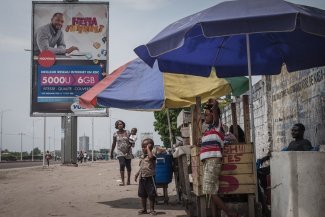This photo from February 2017 shows one of the first Empower Shack structures in the township of Khayelitsha, Cape Town. This year, the low-cost housing project was nominated for the prestigious 2018 RIBA International Prize.
In the lounge room of her two-storey home made from corrugated iron, timber and hollow-core blocks, Magau Mhlupheki is washing clothes using a big plastic bucket. It’s a new experience, even though her water usage is limited by the restrictions put in place to prevent the city from running out of water.
“It’s changed my life,” 45-year-old Mhlupheki says of her new home of the past two years in the Site C section of Cape Town’s Khayelitsha township. “I didn’t have a sink before. I used to collect water from outside to wash the dishes. Now I have a toilet inside. I used to share a toilet on the street.”
Cape Town is a city of stark, largely racialised, inequalities. While it is home to some of the most expensive real estate in the world, a quarter of its mostly black and coloured inhabitants live in informal settlements. Khayelitsha is one of the biggest townships in South Africa, with a population estimated at anything between just under half a million and as much as three times that figure.
According to the 2016 General Household Survey, published by Statistics South Africa, 13.9 per cent of the country’s 16.7 million households live in informal dwellings such as those found in Khayelitsha, mainly thousands of rows of tiny, one-level informal structures that are tightly packed next to each other. It is hoped that the housing upgrades that Mhlupheki and a handful of others now live in will offer an extra solution to South Africa’s housing crisis.
The Empower Shack project was nominated for a Royal Institute of British Architects (RIBA) 2018 International Prize in January, an award given to a “building which exemplifies design excellence, architectural ambition and delivers meaningful social impact,” according to RIBA’s website.
The homes – which were designed and built by the Khayelitsha-based non-profit Ikhayalami working in collaboration with the interdisciplinary design studio Urban-Think Tank (U-TT), based at the Swiss Institute of Technology in Zurich (ETHZ), and the Site C community – stand out for several reasons.
By transforming flimsy, single-storey dwellings with poor ventilation and little or no natural light into sturdy, well-designed, watertight two-storey structures, residents are provided with decent homes that have more space and allow for essential amenities such as sanitation and electricity.
In addition, the practice of “re-blocking” (the replanning of public space) reduces the risk of fire spreading and provides public space for things like road access for emergency services.
Empower Shacks are part formal and part informal: formal because of their concrete block walls, and informal because of the facades which are made from strong corrugated zinc and aluminum sheets. The structures come in six different sizes. Internally, no dividing walls have been built, leaving the residents free to partition the space as they see fit. The prototype design also allows residents extra space for extended family, to work from home or to rent out a room.
Ikhayalami founder and manager Andy Bolnick says the project “acknowledges the ingenuity of shack living” and examines the way in which design can help low-cost housing. “Design is critical for low-cost housing because space is limited and so valuable. You really have to maximise every square inch,” she tells Equal Times.
For example: “We said it’s vital that we go vertical, because there’s such a scarcity of well-located land and space, and we want the poor to have access to the city, the amenities it offers and to be incorporated into the urban fabric as welcome citizens.”
About one billion people across the world live in slums and informal settlements, where they face a lack of basic public services, poor infrastructure, substandard housing and very little government intervention.
South Africa’s lack of decent, affordable housing is rooted in the apartheid era and compounded by politics since 1994, according to Marianne Millstein, a senior researcher at the Norwegian Institute for Urban and Regional Research (NIBR) at Oslo Metropolitan University. “In a post-apartheid scenario, the challenges in housing delivery are a combination of economic realities – lack of money to realise ambitious goals – and political will and capacity to really address the underlying challenges,” says Millstein.
Shack upgrading
The Empower Shack project began when architect and U-TT co-founder Alfredo Brillembourg, who had worked on similar projects in Brazilian favelas, visited South Africa in 2012. He was impressed with Ikhayalami’s work and the idea of “shack upgrading”.
Ikhayalami were equally impressed with Brillembourg’s work and felt that U-TT would also be good partners. The first prototype was built in Switzerland during a 2013 U-TT design workshop supported by Ikhayalami. The second was constructed on-site and was a double-storey shack upgrade. The third, built in the Ikhayalami warehouse, included block walls as fire breaks. Four more units were made in 2015 in-situ. The fifth iteration is currently being constructed. Today, there are a total of 72 dwellings.
Residents stay with family and friends in Khayelitsha while their original homes are being upgraded. The Empower Shacks are mostly funded by the global reinsurance firm Swiss Re but residents are also expected to make a monetary contribution. This is often achieved with the help of project-specific microfinance loans. Meanwhile, the local government has said it will provide all necessary infrastructure including water, sanitation, electricity and drainage for each home.
Local community leader Phumezo Tsibanto used to live with his sister and brother in a hokkie, a shack made from thin zinc sheeting and untreated wood. “One toilet is used by five families,” he tells Equal Times, and the only available water supply comes from a public tap. Tsibanto and his family will be moving permanently into an Empower Shack some time this month.
Tsibanto, 43, says he has been on a waiting list for three decades for an Reconstruction and Development Programme (RDP) home, a government-subsidised brick house. With the City of Cape Town building just 6,000 such houses a year, and between 320,000 and 350,000 people on the list according to one 2017 report, researchers claim that the wait time is as long as 60 years.
One of many solutions
There are a number of other social housing schemes to help speed up the delivery of quality housing, from improving informal settlements such as backyard dwellings (built in the backyards of other properties and recently named the fastest-growing type of rented accommodation in South Africa) to building new homes for low-income and middle-income residents. The Community Resident Units programme, for example, is aimed at converting old single-sex hostels, where migrant workers from rural areas and neighbouring countries were forced to live during apartheid, into family housing.
Of his Empower Shack home, Tsibanto told Equal Times: “Maybe I will end up dying before getting my subsidy [RDP house], but this one is much better while I’m waiting.” But for Brillembourg, the Empower Shack is a permanent housing solution: it offers immediate spatial improvement without displacing residents; the space in an Empower Shack is larger than an RDP house; it is compatible with urban design frameworks; and saves 60 per cent of land and infrastructure compared to a traditional RDP house.
“The idea is to roll out this housing over South Africa as a substitute for RDP housing and use the scheme to re-block shack dwellers,” Brillembourg says.
Charles Rudman, district manager for the Khayelitsha/Mitchells Plain District at the City of Cape Town, says the project ticks all the boxes, “complying with public health, public safety, structural stability and fire regulations with individual access to all services including electricity.” But he says the city council is open to learning how it can be improved. “It will be interesting to do an end user survey to learn from the recipient community how they experience their new living environment and what adjustments are required to be made,” he says. “[But] there is no reason why this project should not be rolled out at scale to address informality in the City.”
For Merhawi Okbaselasie, director of projects at Shack/Slum Dwellers International (SDI) in South Africa, the Empower Shack offers an important alternative to the current housing paradigm: “The dominant housing delivery model is the development of government-driven, lower density greenfield housing developments in the urban periphery, away from social and economic opportunities and transport nodes. Although there is a growing shift in terms of policy towards in-situ upgrading of informal settlements, which mostly are relatively well-located, the shift in practice is seriously lagging behind,” says Okbaselasie.
“The Empower Shack challenges these dominant delivery models and sets a serious precedent for an incremental in-situ upgrading of informal settlements in South Africa.”
Ikhayalami, however, have their sights set further afield. “We are looking at something that can be not only replicable in South Africa but globally,” says Bolnick.










